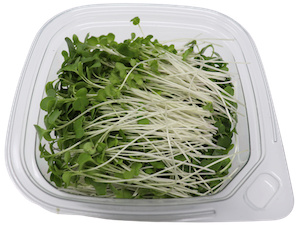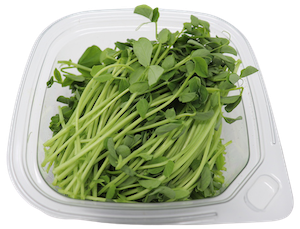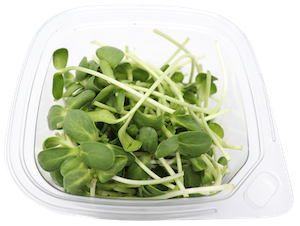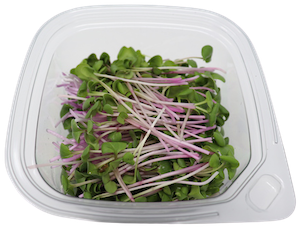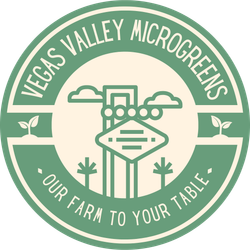Enjoy Fresh, Locally Grown Microgreens: Delivered in Las Vegas
Boost Your Health with Our Las Vegas Grown Microgreens: The Perfect Addition to Any Meal
Unlock the Power of Microgreens:
Did you know that Microgreens pack up to 40 times more nutrients than mature greens like broccoli?
Our locally grown microgreens not only add extra flavor and crunch to your meals, they can also help with:
- Immune system enhancement
- Inflammation reduction
- Gut health improvement
(click here to check out the scientific journals backing these statements)
Hey! We're Tyler and Megan, your local microgreens farmers...

Our 'direct-to-community' farm, Vegas Valley Microgreens, may be small in size but is big on service, offering home deliveries of freshly harvested microgreens across the Vegas Metro area.
We specialize in growing 4 varieties of nutrient-dense microgreens…
Microgreens: Backed by Research, and Loaded with Health Benefits.
- Enhances your immune system
- Reduces inflammation
- Can help contribute to weight loss
- Can help decrease risk of various chronic diseases
- Promotes gut health
- Plus, many more benefits!
What Are Microgreens?
Microgreens represent the initial phase of a vegetable plant's life, following the sprouting stage.
As 'living foods', they are intentionally harvested at their peak nutritional and flavor state.
The picture below clearly differentiates between sprouts on the left, microgreens in the center, and a mature vegetable plant on the right:

Why Microgreens Are Healthier Than Regular Greens Like Lettuce, Spinach & Kale…
- They boast a higher concentration of nutrients
- They contain vitamin and antioxidant levels that can be up to 40 times greater than mature greens
- They offer an abundance in macro minerals, including calcium, magnesium, phosphorus, and potassium
- They are richer in micro minerals like iron, zinc, and copper
- The list continues with them being packed with B vitamins, essential amino acids, folate, and so much more!
Get These Amazing Super Foods Sent Straight To Your Doorstep!
Locally grown in Las Vegas, Nevada
Our top 4 Microgreens:
One of the things we love most about these 4 varieties (other than the countless health benefits) is…
They’re so easy to use!
In fact, if you want to taste REAL FOOD and feel REAL GOOD, we recommend you…
Add them to virtually every single meal…

Salads

Soups

Sandwiches & Wraps

Smoothies & Juices
Those are just a few examples…
We encourage you to get creative and experiment with microgreens…
They can add so much flavor, texture & color to your meals!
Want These Tasty Micros Delivered To Your Doorstep Every Week, Less Than 24 Hours After They’re Harvested?
Locally grown in Las Vegas, Nevada
3 Simple Steps To Get Started Today
- Click the “ORDER NOW” button anywhere on this page
- Select the type of microgreen you want & how much you'd like to order
- Enter your contact details and click "Submit"
We will personally reach out to arrange payment & delivery. That way, we can get started growing your special order so that it's ready when you're ready :)
We look forward to growing for you!
Sincerely,
Tyler & Megan

Q & A
-
What are microgreens?
Microgreens are young vegetable or herb plants that are harvested when they are still in their early growth stages. They are typically harvested around one to three weeks after germination, when they have developed their first true leaves. Microgreens are smaller than baby greens and larger than sprouts, and they are prized for their delicate flavors, vibrant colors, and nutritional value.
Microgreens are usually grown from the seeds of various vegetables, herbs, and edible plants such as pea, broccoli, sunflower, radish, kale, arugula, and many others.
They can be grown in trays or containers filled with a nutrient-rich growing medium such as soil or coconut coir. The seeds are sown densely, and the plants are allowed to grow for a short period under appropriate light and temperature conditions.
Once the microgreens reach the desired size, they are harvested by cutting just above the soil level. The harvested microgreens are then used as a fresh ingredient in salads, sandwiches, wraps, garnishes, and other dishes.
They add a burst of flavor, texture, and visual appeal to meals. Microgreens are popular among chefs, health enthusiasts, and home gardeners due to their concentrated nutritional content, which can be higher than that of their mature counterparts.
Microgreens are also known for their rich concentrations of vitamins, minerals, antioxidants, and phytonutrients. While the nutrient profile varies depending on the specific plant variety, microgreens are generally considered a nutritious addition to a healthy diet.
They are an excellent source of vitamins C, E, and K, as well as beta-carotene and lutein. Additionally, they often contain higher levels of beneficial compounds compared to fully mature plants.
-
How does ordering work?
When you place your microgreens order with us you will get a confirmation via text and email.
We will then send an invoice and reach out to confirm that our next available delivery date will work for you logistically.
Once the invoice is paid, we will start producing your order, specifically for you!
-
Which microgreens are best for you?
Microgreens are young, edible seedlings of various vegetables and herbs that are harvested at an early stage of growth. These tiny greens have gained popularity in recent years due to their concentrated nutrient content and versatile culinary uses. While different microgreens offer various health benefits, here are some popular and nutrient-dense options that are considered beneficial:
- Broccoli Microgreens: These are known for their high levels of sulforaphane, a compound associated with various health benefits, including antioxidant and anti-inflammatory properties.
- Kale Microgreens: Packed with vitamins A, C, and K, as well as minerals like calcium and iron, kale microgreens are nutritious and delicious.
- Spinach Microgreens: Similar to kale, spinach microgreens are rich in vitamins and minerals, especially vitamin K and iron.
- Sunflower Microgreens: These are an excellent source of vitamin E, which is a powerful antioxidant. They also provide healthy fats and other nutrients.
- Radish Microgreens: Radish microgreens are rich in vitamin C, folate, and antioxidants, including sulforaphane.
- Pea Shoots: These microgreens are high in fiber, protein, and various vitamins and minerals like vitamin A and vitamin C.
-
Why are microgreens so much more nutritious?
Microgreens are considered more nutritious than their mature counterparts for several reasons:
- Concentrated Nutrients: Microgreens are harvested at a very early stage of growth, typically within 7 to 21 days after germination. During this short period, the plants accumulate a concentrated amount of nutrients to support their initial growth. As a result, microgreens can contain higher levels of vitamins, minerals, and antioxidants compared to fully grown vegetables and herbs.
- Greater Antioxidant Content: Studies have shown that microgreens can have significantly higher levels of certain antioxidants, such as vitamin C, vitamin E, and beta-carotene, compared to mature plants. Antioxidants help protect the body from oxidative stress and can reduce the risk of chronic diseases.
- Enhanced Phytonutrients: Phytonutrients are plant compounds that have various health benefits. Microgreens have been found to contain a diverse array of phytonutrients, which contribute to their nutritional profile and potential health-promoting properties.
- Digestibility: Some research suggests that the nutrients in microgreens are more easily absorbed by the body compared to those in mature vegetables. This improved digestibility may lead to better utilization of the nutrients by our cells.
- Low-Calorie Option: Microgreens are low in calories and carbohydrates, making them a great addition to a balanced diet, especially for those looking to manage their caloric intake.
- Environmental Factors: Microgreens are typically grown hydroponically or in soil, and their short growth cycle means they are exposed to fewer environmental stressors, such as pollution or pesticides, which can impact the nutrient content.
It's important to remember that while microgreens offer concentrated nutrients, they are meant to be part of a diverse and balanced diet. Eating a variety of fruits, vegetables, and whole foods will provide a broad spectrum of nutrients essential for optimal health.
-
Why are microgreens so expensive?
Microgreens can be more expensive than their fully grown counterparts for several reasons:
- Labor-Intensive Cultivation: Growing microgreens requires meticulous care and attention to detail. The seeds need to be sown densely, and the plants must be harvested at just the right time to ensure the highest nutrient content and best flavor. This labor-intensive process increases the production cost.
- Short Growth Cycle: Microgreens have a very short growth cycle, typically ranging from 7 to 21 days, depending on the variety. Since they reach maturity quickly, they need to be replanted frequently to maintain a steady supply. This frequent replanting also adds to the production cost.
- High Seed Costs: The seeds used for microgreens are usually of high quality and are specifically bred for their tender, flavorful shoots. These specialized seeds can be more expensive than regular vegetable seeds.
- Growing Conditions: Microgreens require controlled environments to thrive. This might involve using specialized growing media, like coconut coir or vermiculite, and providing adequate light and temperature control. Creating and maintaining these optimal conditions can be costly.
- Fragility and Perishability: Microgreens are delicate and perishable, which means they need careful handling and quick distribution to maintain their freshness and quality. The increased risk of spoilage during transportation can add to the overall cost.
- Local Sourcing: Many microgreens are locally grown, which can contribute to higher prices due to the focus on supporting local farmers and the reduced carbon footprint associated with local production.
Despite their higher cost, some people are willing to pay more for microgreens due to their exceptional taste, concentrated nutrient content, and unique culinary uses. Additionally, the convenience of having these nutrient-packed greens readily available, especially in urban areas with limited space for gardening, can justify the higher price for some consumers.
At Vegas Valley Microgreens we always do our best to make sure our pricing is competitive in the market, while still being able to maintain the product quality our customers have come to expect out of us.
-
Are microgreens safe for animals?
Microgreens are generally safe for animals, but there are some considerations to keep in mind:
- Dietary Suitability: While microgreens are nutritious for humans, not all types of microgreens are suitable for animals. Some microgreens, such as broccoli, kale, and spinach, are safe and nutritious for pets. However, there are certain varieties that may be harmful to animals, so it's essential to know which microgreens are safe for your specific pet.
- Avoid Toxic Varieties: Certain microgreens may belong to plant families that are toxic to animals. For example, some members of the nightshade family (Solanaceae) like tomato and potato greens can be toxic to pets. Onions and garlic microgreens are also best avoided for dogs and cats, as these can cause health issues.
- Consult a Veterinarian: Before introducing microgreens or any new food into your pet's diet, it's always a good idea to consult with a veterinarian, especially if you are uncertain about the safety of specific varieties.
- Moderation: While microgreens can be nutritious, they should be offered as part of a balanced diet, not as the sole source of nutrition for animals.
- Allergies: Just like humans, animals can also have food allergies. If you notice any adverse reactions after feeding your pet microgreens, discontinue the practice and consult your veterinarian.
- Avoid Pesticides: If you are growing microgreens at home and plan to share them with your pets, ensure that you use organic, pet-safe growing methods without the use of harmful pesticides or chemicals.
- Avoid Soil Contamination: If you are purchasing microgreens or any vegetables from a store, make sure they haven't been treated with any chemicals or contaminants that could be harmful to animals.
Always do your research and exercise caution when introducing new foods into your pet's diet. If you have any doubts or concerns about feeding microgreens to your pets, consult a veterinarian to ensure their safety and well-being.
Vegas Valley Microgreens never uses harsh chemicals or pesticides.
-
Which microgreens have the most protein?
Among microgreens, some varieties are known for their relatively higher protein content compared to others. Here are a few microgreens that are considered to have more protein:
- Pea Shoots: Pea shoots, also known as pea microgreens, are one of the best sources of protein among microgreens. They can contain about 20-25% protein by dry weight.
- Sunflower Microgreens: Sunflower microgreens are another excellent source of protein, typically containing around 20-25% protein by dry weight.
- Broccoli Microgreens: Broccoli microgreens are well-known for their nutrient density, including protein content. They usually contain about 20-35% protein by dry weight.
- Radish Microgreens: Radish microgreens offer a moderate amount of protein, usually around 20-25% protein by dry weight.
- Amaranth Microgreens: Amaranth microgreens are not as common as others on this list, but they are worth mentioning as they can have a protein content of around 15-20% by dry weight.
-
Which microgreens taste best?
The taste of microgreens can vary widely depending on the variety, as each microgreen has its own unique flavor profile. Some microgreens are mild and subtle, while others are bold and intense.
Ultimately, the best-tasting microgreens are subjective and depend on individual preferences. Here are some popular microgreens known for their appealing taste:
- Pea Shoots: Pea shoots have a sweet, delicate flavor reminiscent of fresh peas. They are often described as crisp and slightly nutty, making them a popular choice for salads, sandwiches, and wraps.
- Sunflower Microgreens: Sunflower microgreens have a nutty and slightly earthy taste. Their crunchy texture and mild flavor make them a versatile addition to various dishes.
- Basil Microgreens: Basil microgreens offer a concentrated version of the classic basil taste, which is sweet, aromatic, and herbal. They are perfect for enhancing the flavor of pasta dishes, pizzas, and salads.
- Cilantro Microgreens: Cilantro microgreens have a milder version of the pungent and citrusy flavor found in mature cilantro. They are commonly used in Latin American, Indian, and Southeast Asian cuisines.
- Radish Microgreens: Radish microgreens have a peppery and slightly spicy taste, similar to mature radishes. They add a burst of flavor to salads and sandwiches.
- Arugula Microgreens: Arugula microgreens have a peppery, nutty, and slightly bitter taste, which is characteristic of mature arugula. They are great for adding zest to salads and sandwiches.
- Kale Microgreens: Kale microgreens have a mild, sweet flavor compared to mature kale. They are a nutritious and tasty addition to salads, smoothies, and sandwiches.
- Mizuna Microgreens: Mizuna microgreens have a pleasant, mild peppery taste with a hint of mustard flavor. They work well in salads and as a garnish for various dishes.
- Red Cabbage Microgreens: Red cabbage microgreens have a mild, earthy taste with a touch of sweetness. They also provide a vibrant purple color to your dishes.
When choosing microgreens for their taste, consider experimenting with different varieties to find the ones that best complement your favorite dishes. The exciting flavors and textures of microgreens can elevate the taste of your meals and add a delightful touch to your culinary creations.
Let us know if there is a variety you would like to try that we do not carry! We are here to deliver exactly what the Las Vegas Valley wants.


